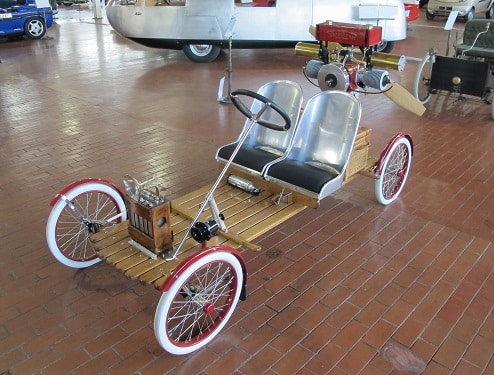
Auto Red Bug with Aerothrust Engine- 1924
In 1916, the A.O. Smith Company of Milwaukee, Wisconsin, introduced an inexpensive buckboard-style cycle car called the Flyer. Driven by a fifth wheel, known as the Smith Motor Wheel,...
VEHICLE DEMONSTRATIONS EVERY SATURDAY & SUNDAY AT 11AM, FREE WITH ADMISSION!
Please note that the cars or exhibit items shown in this database are part of our collection but may not be on display when you visit.
In 1916, the A.O. Smith Company of Milwaukee, Wisconsin, introduced an inexpensive buckboard-style cycle car called the Flyer. Driven by a fifth wheel, known as the Smith Motor Wheel,...
The name DKW comes from “Dampf-Kraft-Wagen” which translates to “steam-powered vehicle.” It carries this name because of the first vehicle its Danish designer, J.S. Rasmussen, built, was a light...
The name DKW comes from “Dampf‐Kraft‐Wagen” which translates to “steam powered vehicle.” It carries this name because the first vehicle its Danish designer, J.S. Rasmussen built was a light...
The name DKW comes from “Dampf-Kraft-Wagen” which translates to “steam powered vehicle.” It carries this name because the first vehicle its Danish designer, J.S. Rasmussen built was a light...
The Monza seen here is one of a handful of survivors, out of an unknown total production numbering fewer than 240. Being such a low-volume car, it is what...
After WWII, the German government sponsored a competition between Borgward, Porsche, and DKW to find a suitable military replacement for the Land Rovers they had used before the war....
The Autobianchi Bianchina is one of the smallest cabriolets ever produced. These convertibles were built atop the Fiat 500 Nuevo chassis, and this second-generation Autobianchi Bianchina has stunning styling,...
The principal derivative of the Fiat Nuevo 500 was the Autobianchi Bianchina. A chic, upmarket product conceived in parallel with the Fiat 500, the Autobianchi firm was part-owned (and...
The Biscuter, or ‘Zapatilla’ (little shoe) as it was known in Spain, was actually built to the design of the French engineer Gabriel Voisin. ‘Biscooter’, the French name, was...
During Japan’s “Bubble Economy” (1986-1991), the nation’s car manufacturers enjoyed a bit of freedom in their car designs. Cars designed for smaller and smaller niche markets were financially feasible...
Birmingham Small Arms was started in 1861. Its main products were machine guns, shotguns, and rifles. In 1880 B.S.A. also started to build bicycles. B.S.A.’s first cars were produced...
The original design of the Spatz was penned by German automaker Egon Brütsch. He was one of the world’s most prolific microcar engineers and designed eleven different car models...
A modern version of the Peel P50, Bamby microcars were built in Hull, England by Alan Evans. Initial marketing targeted the sale of this modern microcar to young drivers...
The 1886 Benz Patent Motorwagen, created by Karl Benz, is widely regarded as the world’s first true automobile. Powered by a single-cylinder, 2/3 horsepower engine, it was designed to...
Hans Berger was a gifted engineer who built small helicopters and various mechanical devices. In 1948 he built the rocket-powered car you see here. Hans Berger also built the...
Berkeley was Britain’s leading caravan maker in the 1950s. In 1956, Lawrie Bond approached Charles Panter of Berkeley Caravans with his new design. It was an ideal project for...
In the 1950s to 1960s, three wheel cars were very popular in Great Britain. For drivers with a motorcycle license, these cars did not require a separate car license....
The Bertone X1/9 is a two-seater sports car designed by Bertone and built by Fiat. Intended to be the first affordable mid-engined sports car, the X1/9 is notable for...
A short-lived classic! The BMW 320 was built for just one year. First presented in July 1937, the 320 showed a close resemblance to the transitional 329. The 320...
The 500-series cars may not have been BMW’s most glamorous products, but these big and sturdy middle-class machines were the mainstays of the company’s car division from 1951 up...
In 1957, BMW brought out a 4-seater development of the Isetta. The 600 (named for its engine size), has two doors: the swing-up front door as on the Isetta,...
The little-known and rarely seen BMW 700 Coupé is arguably one of the most important models in BMW’s post-war history. The first of the series and highest-selling variant...
BMW’s Bavaria model was a US-only model, derived from Europe’s 2500/2800/3000/3300 series of sedans. Known as the E3 among aficionados, it shared everything under the skin with the E9...
One of Germany’s well-known car makers, BMW began building engines for airplanes. Forbidden to continue making airplane engines after WWI, BMW turned to engines for motorcycles and heavy trucks....
Gebráder Ihle Karosserie und Apparatebau was a body shop and engineering company in Germany. After the First World War, it supplied vehicles for fairground operators. In 1934, they designed...
Driven by the need for post-war affordable transportation, BMW decided to supplement slow sales of their larger models with an inexpensive car. In 1955, BMW acquired the license from...
Driven by the need for post-war affordable transportation, BMW decided to supplement slow sales of their larger models with an inexpensive car. In 1955, BMW acquired the license from...
Lawrie Bond designed his first three-wheeler in 1948. His most famous, the Bond Minicar, was the longest-lived and most successful of Britain’s minimal motoring cars. The replacement for the...
Victor Bouffort was known as a creative inventor, engineer, and developer of interesting vehicles and was a quizzical, forward-thinking man. He was commissioned by the French army just after...